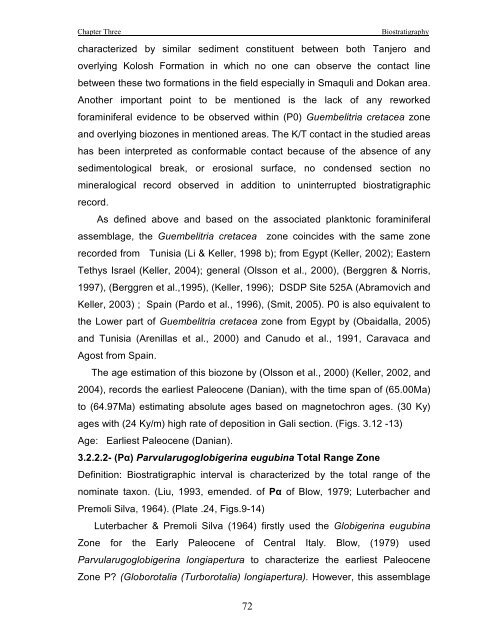biostratigraphy and paleoecology of cretaceous/tertiary boundary in ...
biostratigraphy and paleoecology of cretaceous/tertiary boundary in ...
biostratigraphy and paleoecology of cretaceous/tertiary boundary in ...
You also want an ePaper? Increase the reach of your titles
YUMPU automatically turns print PDFs into web optimized ePapers that Google loves.
Chapter Three Biostratigraphy<br />
characterized by similar sediment constituent between both Tanjero <strong>and</strong><br />
overly<strong>in</strong>g Kolosh Formation <strong>in</strong> which no one can observe the contact l<strong>in</strong>e<br />
between these two formations <strong>in</strong> the field especially <strong>in</strong> Smaquli <strong>and</strong> Dokan area.<br />
Another important po<strong>in</strong>t to be mentioned is the lack <strong>of</strong> any reworked<br />
foram<strong>in</strong>iferal evidence to be observed with<strong>in</strong> (P0) Guembelitria cretacea zone<br />
<strong>and</strong> overly<strong>in</strong>g biozones <strong>in</strong> mentioned areas. The K/T contact <strong>in</strong> the studied areas<br />
has been <strong>in</strong>terpreted as conformable contact because <strong>of</strong> the absence <strong>of</strong> any<br />
sedimentological break, or erosional surface, no condensed section no<br />
m<strong>in</strong>eralogical record observed <strong>in</strong> addition to un<strong>in</strong>terrupted biostratigraphic<br />
record.<br />
As def<strong>in</strong>ed above <strong>and</strong> based on the associated planktonic foram<strong>in</strong>iferal<br />
assemblage, the Guembelitria cretacea zone co<strong>in</strong>cides with the same zone<br />
recorded from Tunisia (Li & Keller, 1998 b); from Egypt (Keller, 2002); Eastern<br />
Tethys Israel (Keller, 2004); general (Olsson et al., 2000), (Berggren & Norris,<br />
1997), (Berggren et al.,1995), (Keller, 1996); DSDP Site 525A (Abramovich <strong>and</strong><br />
Keller, 2003) ; Spa<strong>in</strong> (Pardo et al., 1996), (Smit, 2005). P0 is also equivalent to<br />
the Lower part <strong>of</strong> Guembelitria cretacea zone from Egypt by (Obaidalla, 2005)<br />
<strong>and</strong> Tunisia (Arenillas et al., 2000) <strong>and</strong> Canudo et al., 1991, Caravaca <strong>and</strong><br />
Agost from Spa<strong>in</strong>.<br />
The age estimation <strong>of</strong> this biozone by (Olsson et al., 2000) (Keller, 2002, <strong>and</strong><br />
2004), records the earliest Paleocene (Danian), with the time span <strong>of</strong> (65.00Ma)<br />
to (64.97Ma) estimat<strong>in</strong>g absolute ages based on magnetochron ages. (30 Ky)<br />
ages with (24 Ky/m) high rate <strong>of</strong> deposition <strong>in</strong> Gali section. (Figs. 3.12 -13)<br />
Age: Earliest Paleocene (Danian).<br />
3.2.2.2- (Pá) Parvularugoglobiger<strong>in</strong>a eugub<strong>in</strong>a Total Range Zone<br />
Def<strong>in</strong>ition: Biostratigraphic <strong>in</strong>terval is characterized by the total range <strong>of</strong> the<br />
nom<strong>in</strong>ate taxon. (Liu, 1993, emended. <strong>of</strong> Pá <strong>of</strong> Blow, 1979; Luterbacher <strong>and</strong><br />
Premoli Silva, 1964). (Plate .24, Figs.9-14)<br />
Luterbacher & Premoli Silva (1964) firstly used the Globiger<strong>in</strong>a eugub<strong>in</strong>a<br />
Zone for the Early Paleocene <strong>of</strong> Central Italy. Blow, (1979) used<br />
Parvularugoglobiger<strong>in</strong>a longiapertura to characterize the earliest Paleocene<br />
Zone P? (Globorotalia (Turborotalia) longiapertura). However, this assemblage<br />
72

















